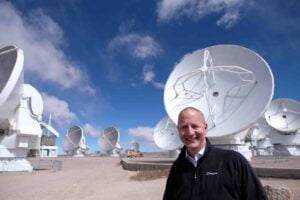Prof. Rob Ivison
European Southern Observatory (ESO), Director of Science
September 20th, 2023 – 3:30 pm–5:00 pm – ARRC Auditorium, 26 Dick Perry Ave, Kensington, 6151, WA
A bus has been arranged to transfer people from ICRAR/UWA to the venue, leaving @2:45pm from the main entrance of the Ken & Julie Michael building.
30 Years of Submillimetre Cosmology

The Universe that cooled from a cosmic fireball just shy of 14 billion years ago was comprised almost entirely of Hydrogen and Helium, with negligible quantities of the heavier elements. Astronomers seek to understand how and when the abundances of the various elements have changed. Since heavy elements are largely forged in stars – indeed, we are the leftovers from one or more of those stars – the cosmic history of star formation has a profound influence: how many and what kind of stars are forming at any particular time? As we have peered ever further into space – and thus back in time, to several times the age of the Earth ago – we have found ever more distant populations of stars, lighting up galaxies. A seemingly ubiquitous feature of the most intensely star-forming galaxies is an abundance of dust – tiny particles formed in the winds of stars, or in supernovae, with sizes measured in microns. Towards the end of the last century, infrared telescopes in space hinted that conventional optical telescopes might be blind to some the most active parts of the Universe due to the pernicious effects of this dust, which almost completely absorbs any light from stars, as well as from any black holes lurking in their centres. This can render even the most active, luminous galaxies entirely invisible to conventional telescopes. Submillimetre cosmology exploits a bizarre quirk of physics known as the negative K correction to detect these dusty galaxies, and does so almost independently of how far they are away from us: a neat trick, by any standards. Submillimetre observations thus offer a relatively clear view of the most intensely star-forming galaxies – some harbouring a billion times the mass of our Sun in tiny dust particles and about as visible as a pile of coal – right the way back to the very early Universe. But are all star-forming galaxies dusty? The very first results from the James Webb Space Telescope have been entertaining. I describe a journey of discovery in Submillimetre Cosmology, spanning 30 years, from single-pixel devices to pioneering cameras and the multi-B interferometer, ALMA.